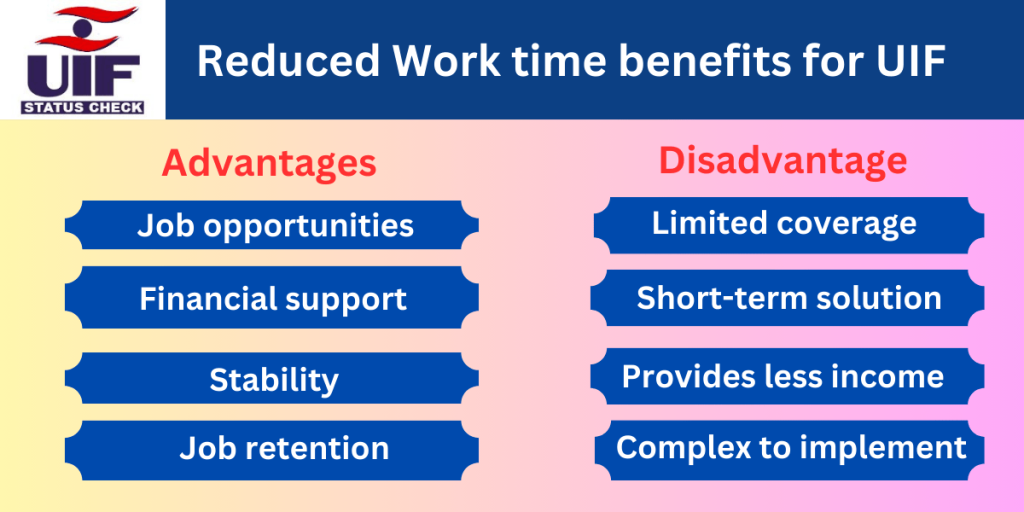UIF Reduced Work Time Benefits | Simple Guide

Reduced work time benefits is a form of financial support given to employees whose work time has been reduced. We will explore thoroughly about the UIF reduced work time benefits in this article.
Reduced work time benefit is a form of financial support given to individuals who experience reduction in their working hours due to various reasons. These reasons might include economic downturns or other unforeseen circumstances. This benefit aims to alleviate the financial burden on the employees whose salaries have been decreased due to less hours of working.
Furthermore, this benefit is designed to help employees maintain a certain level of financial stability while the normal working hours have been reduced. This specific situation arises due to economic challenges and that is why employers need to cut costs.
Read also: UIF Maternity Leave Benefits: Application process and Key pointers
Employers cut the cost not by laying off employees but reducing their working hours. UIF provides relief to these employees whose salaries have been cut due to reduced working hours. This approach can help organizations and companies to stand back on their feet while also providing partial financial relief to employees.
Eligibility criteria for Reduced Work time benefits
In order to claim UIF reduced time benefits, individuals must qualify for certain requirements. Some of the most common requirements include:
The employee must have experienced the reduction in his working hours to request for reduced work time benefits. Employees may also need to include an explanation of why they are facing the specific issue.
In many cases, employers request reduced work time benefits for their employees. This request may need to include reasons why the company is reducing working hours for their employees.
To claim this benefit, employees must have contributed to the UIF or similar scheme. This ensures that they are eligible to claim this benefit.
You may be excluded from claiming Reduced work time benefits if you are self employed or an independent contractor.
How are Reduced work time benefits calculated
You can calculate the reduced work time benefit by subtracting the loss of income from the full time earning and then apply the compensation percentage to this lost income for the benefit amount.
You need to first determine the full time working income of the employee and calculate the benefit based on the decreased working hours. For example, if you are earning 20,000 for a full time job and then your time is reduced to half and now you get 10,000. If the UIF program covers 60% of the lost income then you will get 6000 as your UIF benefit payment.
Note that the amount may vary depending on different circumstances of the employees.
Claiming UIF “Reduced working Time” Benefit
This benefit can be claimed by workers who want to work for a short period of time. This benefit was introduced in the year 2018. The documents required to initiate the process is mentioned below:
Documents
Note: Get all your forms for UIF here .
Features
Procedure
Advantages of Reduced Work time benefits

Financial support:
The main benefit of this is financial support provided to people whose work time hours are reduced. Claiming this benefit helps them maintain financial stability and manage daily life expenses.
Job retention:
Reduced work time benefits encourage the employers to not dismiss workers from their company but instead put them on a reduced work time schedule. This way can help companies preserve hard working employees and prevent the negative impact of unemployment.
Job opportunities:
Companies and organizations try to provide job opportunities for the individuals claiming reduced work time benefit.
Stability in personal life:
Employees can spend more time with their families and manage it more efficiently due to reduced working hours. This also promotes a healthy environment for the society.
Disadvantages of Reduced work time benefits
While the advantages of reduced work time are various, they also come with challenges and drawbacks.
Limited coverage:
Not all employers may be eligible for this benefit. Employees who already work part time or have irregular work schedules may face difficulties claiming full benefits.
Short-term solution:
Reduced work time benefits are intended only as a short term solution. If the reduced work time period is extended then employees may need to find other opportunities to get financially stable.
Provides less income:
Due to the salary cut and reduced work time the overall income decreases for individuals. The income may only be sufficient just to fulfill daily necessities and nothing more.
Complex to implement:
To implement and manage the reduced work time for the employees is administratively complex. Employers may need to produce an accurate working schedule for his employees while ensuring compliance with regulations.
FAQs
Conclusion
To conclude, the UIF reduced work time benefit is indeed a beneficial program for individuals facing reduced hours due to specific reasons. However, employees must understand the eligibility criteria for this program to claim the benefits .
Furthermore, reduced work time benefit is a safety net for many that provides continuity and stability in the workforce which benefits both the employee and the employer. Remember to stay informed regarding the UIF benefits so you can claim it when the challenges may arise.






